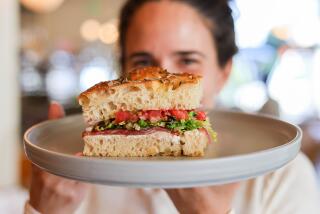What Could Be Nicer Than Otto’s Bread Slicer?
- Share via
“The greatest thing since sliced bread” has been a proverbial expression for 70 years. By now it has a quaint, even faintly ironic ring--was sliced bread really greater than computers, space travel and pull-tab cans?--but when Otto Rohwedder introduced his bread-slicing machine in 1928, people really were impressed. Within five years, 80% of the bread in the country was being sold pre-sliced.
Today we seem to think this was because sliced bread was a convenience, like frozen food. It certainly was convenient, but the thing that really excited Americans about Rohwedder’s machine was the fact that it made more regular slices than the average person could accomplish with a bread knife. In particular, it did a sterling job on the sort of soft, puffy, almost cake-like white bread Americans loved as a symbol of moving up from one’s impoverished immigrant heritage (in a later generation, of course, the upwardly mobile would make a point of preferring dense, coarse peasant breads).
This wasn’t just an aesthetic matter, either. Machine-sliced bread must have nipped in the bud many a potential tantrum about whether one sibling was getting a larger slice than the others. Above all, sliced bread made it possible to make perfectly even toast.
As it happened, just a year before Rohwedder’s invention, Charles Strife had patented another device that was destined to conquer America’s kitchens: the electric pop-up toaster, which could guarantee that your toast wouldn’t burn, even if nobody was watching it continuously. Here’s the thing: On the toasting gadgets that had existed up to that time, it had been possible to get by with sloppily sliced bread, but the pop-up toaster might jam if you didn’t feed it perfectly regular slices. And that wasn’t the kind of jam you wanted with your toast.
More to Read
Eat your way across L.A.
Get our weekly Tasting Notes newsletter for reviews, news and more.
You may occasionally receive promotional content from the Los Angeles Times.








